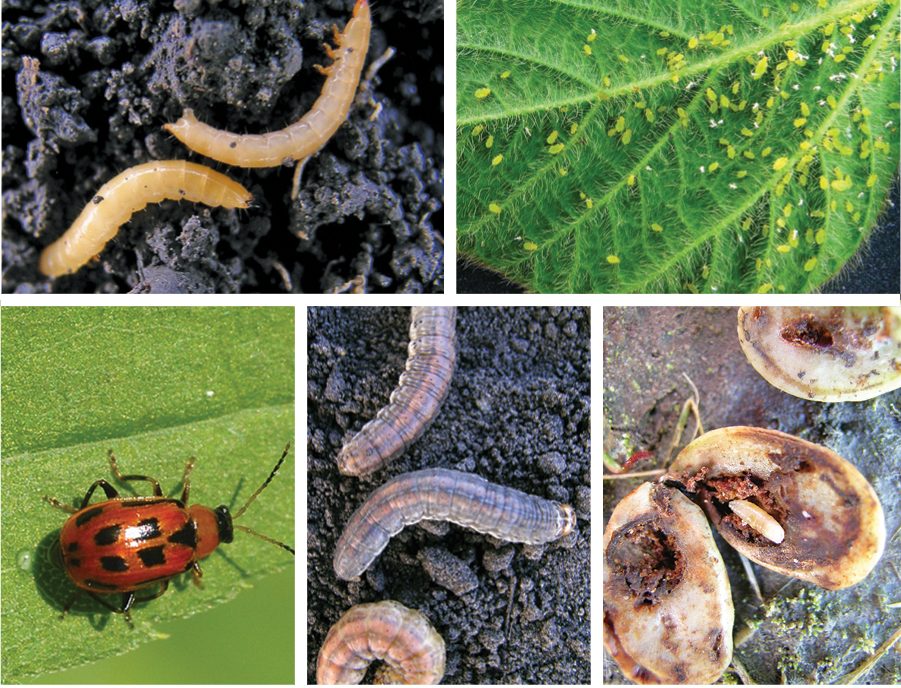Bryan Cassone, Kiana Wiebe and Ivan Drahun, Brandon University
WHAT ARE WIREWORMS?
Wireworms are the soil-dwelling larvae of click beetles. They are slender, hard bodied, yellowish to brown-orange with short legs. The size of fully-grown larvae varies between species, but are usually no longer than 25 mm.
There are at least 30 pest species of wireworm in Canada, and several are found in Manitoba. What makes wireworms unique among insect pests is their long-life span. The adult beetles deposit their eggs in the soil during the summer. The newly hatched larvae can spend several years in the soil before emerging as adults.
Our most common species in Manitoba generally spends two to three years as a larva in the soil, but for other species the life cycle can be five or more years.

WHY ARE WIREWORMS IMPORTANT TO MANITOBA CROP PRODUCTION?
While the adult beetles are harmless, the larvae are voracious eaters and can cause significant crop damage. Wireworms are pests of many agricultural crops, including soybeans, corn, sorghum, small grains, and potatoes.
Wireworm injury to soybeans occur mainly during the early stages of plant growth. They feed on and damage one or more portions of a seed or can completely hollow it out, leaving only the seed coat. Wireworms may also cut off small roots or tunnel into the underground portions of seedlings, causing young plants to appear stunted or wilted.
Damage to either the seed or seedling can result in gaps within the rows, lowering overall crop yields. If infestations are severe enough, they can decimate the crop yields for an entire field, although this is not common in Manitoba. Given their long larval lifespan, once wireworms establish in a field, they can pose a serious risk to the crops in rotation for years to come.
HOW DO WE DETERMINE IF A FIELD IS INFESTED WITH WIREWORMS?
There are two methods commonly used to estimate the presence and/ or abundance of wireworms in a field: soil coring and bait trapping. Soil coring involves the direct sampling of known volumes of soil and counting the wireworms present. This method provides information on the number of wireworms but is labour intensive (several dozen samples must be taken per field) and can underestimate abundance in fields where population densities are low.
Bait traps work by releasing carbon dioxide (CO2)into the soil, which serves as an attractant for wireworms. Several different baits exist, which commonly contain vegetables and/ or cereal food mixtures. The traps are placed about a foot underground for 10–14 days and are then brought back to the laboratory to extract the wireworms. Competing CO2 sources from an abundance of plants in the soil around where the baits are buried can greatly reduce the number of wireworms recovered.



WIREWORMS ARE NOT UNCOMMON IN MANITOBA
In 2018, we carried out surveys of wireworm presence and abundance in 22 crop fields throughout southern Manitoba. Each field included in the survey had previously suspected a presence of wireworms and was scouted three times during the growing season. Far and away the best time to trap wireworms was in the spring prior to planting, presumably due to the ideal soil temperatures and lack of competing CO2 sources. Preliminary results confirm previous findings from the Prairie Pest Monitoring Network. Of the wireworms sampled, the species Hypnoidus bicolor predominated (94% of wireworms identified) but five other known pest species were also found.
HOW TO CONTROL WIREWORMS
Wireworms were effectively managed by the pesticide lindane until its government-issued ban in 2004. Since then, there has been concern the population may be growing and spreading. There are no effective ways to control the pest after the crop is planted, but there are a variety of seed treatments available. Most of these belong to a group of insecticides called neonicotinoids, some of which are currently under review.
Although they rarely cause mortality, these insectistatic compounds protect seeds and seedlings from wireworms. The feeding larvae become moribund and sluggish, allowing the plant time to develop stem and root systems that are strong enough to withstand future attack. Other control methods include crop rotation (buckwheat and mustard are good options), intense plowing (which may often not be practical because of soil health consequences), and soil flooding.
OUR NEXT STEPS
We will continue to scout wireworms throughout southern Manitoba fields during the 2019 and 2020 production cycles. Collected wireworms also undergo genetic analyses to better determine species composition (wireworms are known to be “cryptic” where two or more species can look the exact same) and to assess their ability to disperse between fields. We are also carrying out climate-controlled assays to directly evaluate wireworm behaviour and damage to soybeans under different conditions (such as soil type and temperature). This data will inform economic thresholds of wireworm damage, which are sorely needed for management recommendations.
Would you like to have your field scouted for wireworms?
We are looking for southern Manitoba crop fields to survey for wireworms in 2019. If interested, please contact Bryan Cassone by email cassoneb@brandonu.ca or phone 204-727-7333. A crop rotation history that includes soybeans is desirable but not compulsory.

